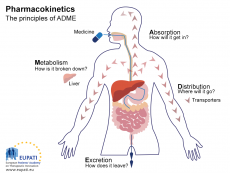

An introduction into Pharmacokinetics
Pharmacokinetics is the branch of pharmacology concerned with the movement of drugs within the body, which can be affected by metabolism. Drugs take a route of administration, referred to ADME. ADME stands for: Absorption, Distribution, Metabolism and Excretion. Drug development aims to achieve drug concentrations within the therapeutic range. The therapeutic range is the concentration of drug in the body which is sufficient to give effective therapy with limited adverse effects. Whilst we could use a highly potent drug to ensure we get the desired effect, the adverse effects are likely to be huge (toxic.) If drug concentrations are not sufficient then we will have ineffective therapy (failure.) Bioavailability is the proportion of drug available at the site of action, when developing a drug, we want the drug to be 100% bioavailable. If it is not then it is essentially a waste of drug and we may not achieve the therapeutic range.
There are several routes of administration that can be taken. Firstly, the intravenous route of injection. This produces 100% bioavailability as the drug straight away enters circulation to reach the site of action (so is quick to be effective.) However, there are some disadvantages. Administering the drug can be difficult and dangerous if not done properly. Equipment must be sterile and trained personnel are necessary. So, this all can be rather expensive and has to be done in the doctors or in hospitals. An alternative is the oral route of administration, which almost always leads to less than 100% bioavailability. But it is safer, cheaper and more convenient. For example, with an injection, we will need staff to administer each individual, whilst the majority of people are able to take a drug by themselves. Oral drugs can have side effects however, such as vomiting. It also requires patient compliance, we have to trust that the patient will take the drug when they are meant to.
Most drug absorption takes place in the gut through passive diffusion, other routes can be by: active transport, ion pair absorption, pinocytosis and solvent drag. Unionised or uncharged drugs are the better absorbed drugs. There are 3 main sites of drug absorption: the small intestine, stomach and colon. The small intestine is the key player for absorption, it has a very large surface area, which is maximised by microvilli and has a large blow flow of 1 litre per minute. The stomach has a lower blood flow of 150ml per minute and is quick to empty. But the stomach absorption can be affected by food. The colon is involved in very little absorption, but the lumen is filled with lots of bacteria so this causes extensive metabolism.
The formulation of the drug is important. From a tablet, it needs to be broken down into granules and then fine particles. We need the drug to have some strength so that when we break it, it does not fall apart, but it cannot be so strong that it cannot be broken down and used.
image- https://www.eupati.eu/glossary/pharmacokinetics/

0 Comment:
Be the first one to comment on this article.